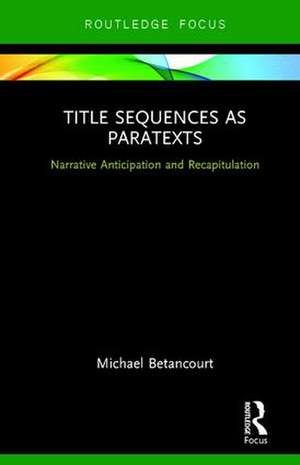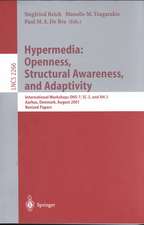Title Sequences as Paratexts: Narrative Anticipation and Recapitulation: Routledge Studies in Media Theory and Practice
Autor Michael Betancourten Limba Engleză Hardback – 2 noi 2017
| Toate formatele și edițiile | Preț | Express |
|---|---|---|
| Paperback (1) | 198.45 lei 6-8 săpt. | |
| Taylor & Francis – 17 dec 2019 | 198.45 lei 6-8 săpt. | |
| Hardback (1) | 461.03 lei 6-8 săpt. | |
| Taylor & Francis – 2 noi 2017 | 461.03 lei 6-8 săpt. |
Preț: 461.03 lei
Preț vechi: 542.40 lei
-15% Nou
Puncte Express: 692
Preț estimativ în valută:
88.22€ • 92.35$ • 72.99£
88.22€ • 92.35$ • 72.99£
Carte tipărită la comandă
Livrare economică 05-19 aprilie
Preluare comenzi: 021 569.72.76
Specificații
ISBN-13: 9781138572621
ISBN-10: 1138572624
Pagini: 176
Ilustrații: 1 Tables, black and white; 40 Illustrations, black and white
Dimensiuni: 138 x 216 x 11 mm
Greutate: 0.14 kg
Ediția:1
Editura: Taylor & Francis
Colecția Routledge
Seria Routledge Studies in Media Theory and Practice
Locul publicării:Oxford, United Kingdom
ISBN-10: 1138572624
Pagini: 176
Ilustrații: 1 Tables, black and white; 40 Illustrations, black and white
Dimensiuni: 138 x 216 x 11 mm
Greutate: 0.14 kg
Ediția:1
Editura: Taylor & Francis
Colecția Routledge
Seria Routledge Studies in Media Theory and Practice
Locul publicării:Oxford, United Kingdom
Public țintă
Postgraduate, Professional, and UndergraduateCuprins
List of Figures
Acknowledgements
1 INTRODUCTION
Acknowledgements
1 INTRODUCTION
Limina2 Narrative Exposition
Anticipation and Recapitulation
Problems of Cinematic Paratext
Pseudo-Independence3 Expositional Modes
Intratextuality
The Allegory mode4 The Comment mode
Lexical Expertise
Narrative Futurity5 The Summary mode
Intertextuality and Quotation
Complex Summary6 The Prologue mode
Narrative Restatement
Realist Integration7 CONCLUSIONS
Expository Texts
The Paradoxes of Cinematic ParatextIndex
Typography and Pseudo-Independence
The Ideology of Naturalism::Stylization
Notă biografică
Michael Betancourt is an artist/theorist concerned with digital technology and capitalist ideology. His writing has been translated into Chinese, French, Greek, Italian, Japanese, Persian, Portuguese, and Spanish, and been published in magazines such as The Atlantic, Make Magazine, Millennium Film Journal, Leonardo, Semiotica, and CTheory. He wrote The ____________ Manifesto, and other books such as The Critique of Digital Capitalism, The History of Motion Graphics, Semiotics and Title Sequences, Synchronization and Title Sequences, Glitch Art in Theory and Practice, and Beyond Spatial Montage: Windowing. These publications complement his movies, which have screened internationally at the Black Maria Film Festival, Art Basel Miami Beach, Contemporary Art Ruhr, Athens Video Art Festival, Festival des Cinemas Differents de Paris, Anthology Film Archives, Millennium Film Workshop, the San Francisco Cinematheque’s Crossroads, and Experiments in Cinema, among many others.
Descriere
In his third book on the semiotics of title sequences, Title Sequences as Paratexts, theorist Michael Betancourt offers an analysis of the relationship between the title sequence and its primary text—the narrative whose production the titles credit. Using a wealth of examples drawn from across film history—ranging from White Zombie (1931), Citizen Kane (1940) and Bullitt (1968) to Prince of Darkness (1987), Mission: Impossible (1996), Sucker Punch (2011) and Guardians of the Galaxy, Vol. 2 (2017)—Betancourt develops an understanding of how the audience interprets title sequences as instances of paranarrative, simultaneously engaging them as both narrative exposition and as credits for the production. This theory of cinematic paratexts, while focused on the title sequence, has application to trailers, commercials, and other media as well.




























